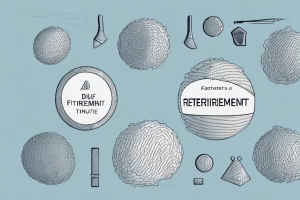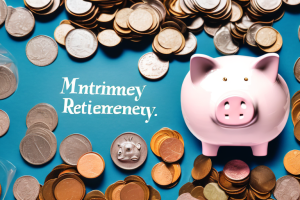Retirement is a major life transition that involves careful planning and consideration. To help individuals navigate this phase successfully, it can be useful to understand the 4 D’s of retirement. In this comprehensive article, we will explore each of the 4 D’s in detail, providing valuable insights and guidance for those who are preparing for or currently in retirement.
Understanding the basics: What is retirement and why is it important?
Retirement is the period in life when individuals choose to stop working on a full-time basis and instead focus on leisure, relaxation, and pursuing personal interests. It is a time of financial independence, where one’s income is primarily derived from retirement savings, investments, government benefits, and possibly part-time employment.
Retirement is significant as it marks the end of the traditional working years and provides individuals with the freedom to enjoy life without the constraints of a regular job. It allows for exploration, personal growth, and the pursuit of long-held dreams and goals.
During retirement, individuals have the opportunity to spend more time with their loved ones and engage in activities that bring them joy and fulfillment. Whether it’s traveling, volunteering, or pursuing hobbies, retirement allows individuals to prioritize their own well-being and happiness.
Furthermore, retirement planning is crucial to ensure financial security during this phase of life. It involves making informed decisions about saving, investing, and managing expenses to ensure a comfortable retirement. By starting early and regularly contributing to retirement accounts, individuals can build a nest egg that will support them throughout their retirement years.
The 4 D’s of retirement: A comprehensive overview
The 4 D’s of retirement can be summarized as follows: Deciding when to retire, Determining your retirement income needs, Developing a retirement savings strategy, and Designing your ideal retirement lifestyle. Let’s delve into each of these D’s in greater detail.
Deciding when to retire is a crucial aspect of retirement planning. It involves considering factors such as your financial readiness, health, and personal goals. Some individuals may choose to retire early, while others may opt to work longer to maximize their savings and Social Security benefits.
Determining your retirement income needs is another important step. This involves assessing your current expenses and estimating how they may change in retirement. It’s essential to consider factors such as healthcare costs, inflation, and any potential sources of income, such as pensions or rental properties.
Developing a retirement savings strategy is key to ensuring a financially secure retirement. This may involve contributing to retirement accounts such as 401(k)s or IRAs, diversifying investments, and regularly reviewing and adjusting your savings plan as needed. It’s important to start saving early and consistently to take advantage of compounding interest and maximize your savings potential.
Designing your ideal retirement lifestyle is the final D in the 4 D’s of retirement. This step involves envisioning how you want to spend your retirement years and planning accordingly. It may include factors such as travel, hobbies, volunteer work, or spending time with family and friends. Creating a realistic budget and considering any potential lifestyle changes is essential in ensuring a fulfilling retirement.
D1: Deciding when to retire – Factors to consider
Deciding when to retire is a crucial aspect of retirement planning. Several factors need to be considered when determining the optimal retirement age, including financial readiness, health, and personal aspirations. It is essential to carefully analyze your financial situation, assess your retirement savings, and have a clear understanding of your retirement income streams. Additionally, taking stock of your overall health and considering any personal goals, such as traveling or spending quality time with family, can contribute to this decision-making process.
D2: Determining your retirement income needs – Budgeting for the future
To ensure a comfortable retirement, it is essential to accurately determine your retirement income needs. This involves creating a comprehensive budget that accounts for various expenses such as housing, healthcare, groceries, transportation, and leisure activities. It is crucial to consider both essential and discretionary expenses and adjust your budget accordingly. Taking into account inflation and potential healthcare costs is also vital to ensure your financial security throughout your retirement years.
D3: Developing a retirement savings strategy – Tips and tricks for financial success
To build a solid financial foundation for retirement, it is important to develop a retirement savings strategy. This typically involves contributing to retirement accounts such as 401(k)s, IRAs, or pensions, taking advantage of employer matching contributions, and considering other investment options. It is advisable to diversify your investments to mitigate risk and seek professional advice if needed. Regularly reviewing and adjusting your savings strategy as life circumstances change is also crucial for long-term financial success.
D4: Designing your ideal retirement lifestyle – Pursuing your passions and dreams
Retirement offers a unique opportunity to design and live your ideal lifestyle. This may involve pursuing hobbies, traveling, engaging in volunteer work, or starting a new business venture. It is important to define your retirement goals and aspirations and create a plan to achieve them. By identifying your passions, exploring new opportunities, and maintaining social connections, you can ensure a fulfilling and purposeful retirement.
Planning for retirement: Steps to take before entering the 4 D’s phase
Prior to entering the 4 D’s of retirement, there are several crucial steps to take. These include assessing your overall financial situation, evaluating your insurance coverage, such as health and long-term care insurance, and creating an emergency fund. It is also important to consider estate planning, including creating a will, establishing power of attorney, and updating beneficiaries. Taking these necessary precautions will provide peace of mind and set the stage for a successful retirement journey.
Retirement readiness checklist: Assessing your preparedness for the 4 D’s
Assessing your readiness for the 4 D’s of retirement can provide valuable insights into your overall retirement preparedness. This checklist may include reviewing your retirement savings, evaluating your healthcare coverage, considering your desired retirement age, and planning for potential care needs. By addressing these key areas, you can ensure that you are adequately prepared for a smooth transition into retirement.
Common challenges faced during the 4 D’s of retirement and how to overcome them
While retirement is often seen as an exciting phase, it can also present challenges. Some common challenges include adjusting to a fixed income, finding meaningful ways to spend time, and managing health care costs. By staying proactive, engaging in social activities, and seeking support from friends, family, or support groups, these challenges can be overcome, ensuring a fulfilling retirement experience.
The psychological impact of transitioning into retirement – Managing emotions effectively
The psychological impact of transitioning into retirement should not be underestimated. Many individuals experience a mix of emotions, including excitement, uncertainty, and a loss of identity tied to their career. It is important to recognize and manage these emotions effectively. Engaging in activities that provide a sense of purpose, seeking support from loved ones, and considering counseling or coaching services can all be helpful in navigating this emotional journey.
Social aspects of retirement – Building and maintaining a strong support network
A strong support network is crucial during retirement. Building and maintaining social connections can help combat feelings of isolation and promote overall well-being. Engaging in group activities, joining clubs or organizations aligned with your interests, and staying connected with family and friends are excellent ways to foster meaningful relationships throughout your retirement years.
Health considerations in retirement – Staying physically and mentally fit
Maintaining good health is vital for enjoying a fulfilling retirement. Adopting a healthy lifestyle that includes regular exercise, a balanced diet, and regular medical check-ups can help prevent health issues and ensure a higher quality of life. Additionally, staying mentally active by engaging in puzzles, reading, or learning new skills can promote cognitive health and contribute to overall well-being.
Work-life balance in retirement – Exploring part-time employment opportunities or hobbies
Retirement does not necessarily mean completely ceasing work. Many individuals choose to explore part-time employment opportunities or engage in hobbies that provide a sense of purpose and fulfillment. Whether it is volunteering, starting a small business, or pursuing a passion project, finding the right balance between leisure and productivity can contribute to a well-rounded retirement experience.
Retirement myths debunked: Addressing misconceptions about the 4 D’s
Retirement is often surrounded by myths and misconceptions that can impact one’s perception and planning. Common myths may include assumptions about financial security, health, and overall happiness during retirement. By addressing these misconceptions and seeking accurate information, individuals can make informed decisions and plan accordingly, ensuring their retirement journey aligns with their expectations and goals.
Financial planning tools and resources for navigating the 4 D’s of retirement
Several financial planning tools and resources are available to help individuals navigate the complexities of retirement. These tools may include retirement calculators, budgeting apps, and online resources that provide in-depth information on retirement planning, investment strategies, and tax considerations. Utilizing these tools and seeking guidance from professionals can enhance your financial preparedness and ensure a solid foundation for a successful retirement.
Long-term care planning in retirement – Understanding options and costs
Long-term care is an important consideration in retirement planning. Understanding the available options, such as home care, assisted living, or nursing homes, as well as the associated costs, can help individuals make informed decisions. Considering long-term care insurance or other financial strategies can provide peace of mind and protect your retirement savings from unexpected expenses.
Estate planning essentials for a smooth transition during the 4 D’s phase
Estate planning is crucial for a smooth transition during the 4 D’s phase. This involves creating a comprehensive plan that outlines your wishes for asset distribution, healthcare decisions, and guardianship of dependents, if applicable. It also includes naming beneficiaries and establishing trusts, if necessary. Consulting with an estate planning attorney can help ensure your wishes are properly documented and legally protected.
Retirement tax strategies to optimize your income during the 4 D’s period
Tax planning is an integral part of retirement planning. Understanding retirement tax strategies and effectively managing your income can help optimize your financial resources. Strategies may include managing withdrawals from retirement accounts, considering Roth conversions, and strategically timing Social Security benefits. It is advisable to consult with a tax professional who specializes in retirement planning to identify the best tax-saving opportunities for your specific situation.
Adjusting your investment portfolio for a more conservative approach in retirement
In retirement, it is often prudent to adjust your investment portfolio to a more conservative approach. This may involve reallocating assets to lower-risk investments that prioritize capital preservation rather than growth. Diversifying your investments across asset classes, such as stocks, bonds, and real estate, can help create a balanced and resilient portfolio. Regularly reviewing and rebalancing your investments to align with your risk tolerance and financial goals is essential for long-term financial security.
In conclusion, understanding and effectively navigating the 4 D’s of retirement is crucial for a successful and fulfilling retirement journey. By carefully considering each of the D’s – deciding when to retire, determining retirement income needs, developing a savings strategy, and designing your ideal lifestyle – you can build a solid foundation for this exciting phase of your life. Additionally, addressing common challenges, considering social and health aspects, and utilizing financial planning tools and resources will contribute to a holistic and well-prepared retirement. Remember, retirement is not just an end but a new beginning, a time to explore, grow, and enjoy a well-deserved chapter in life.



